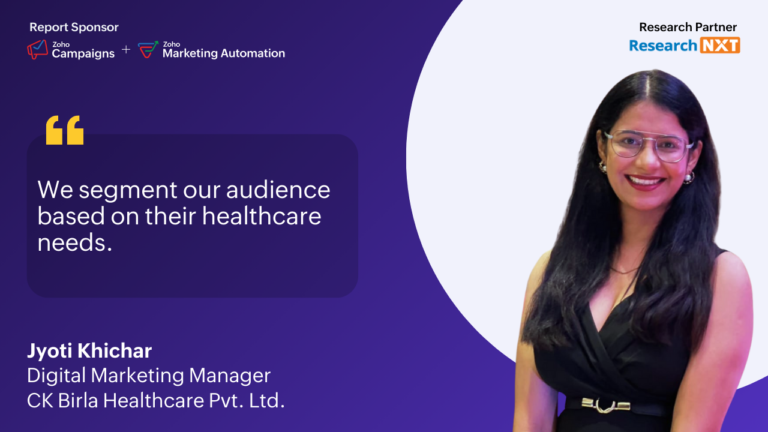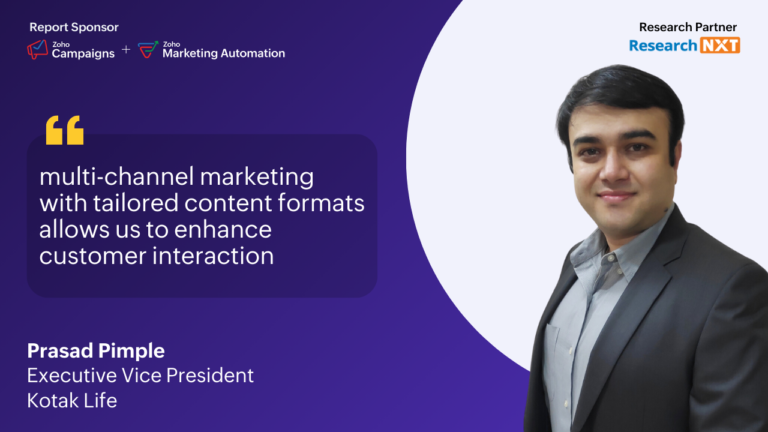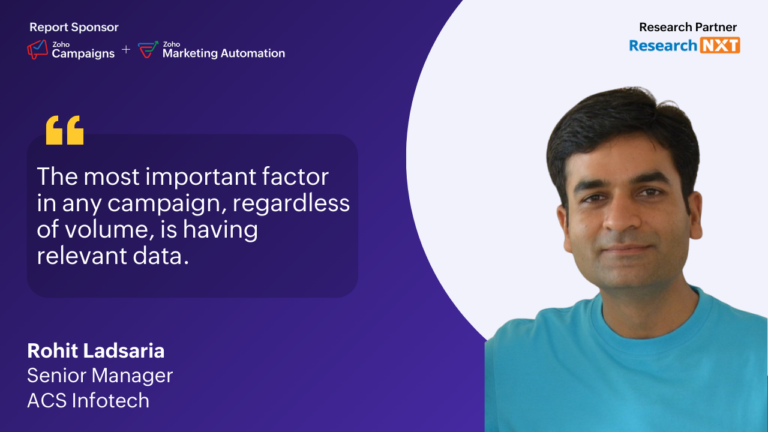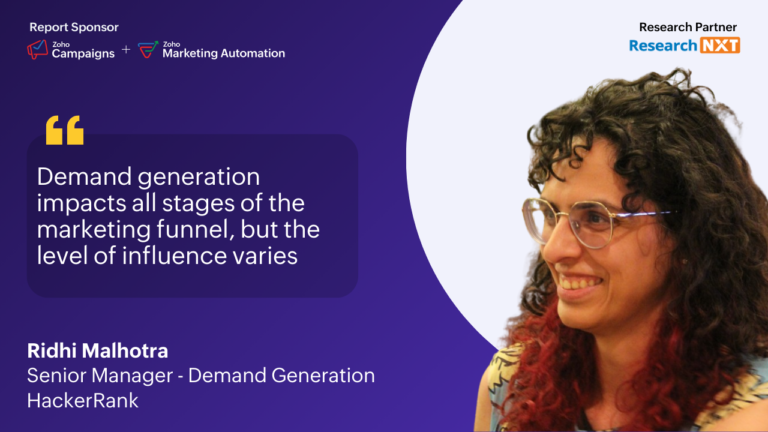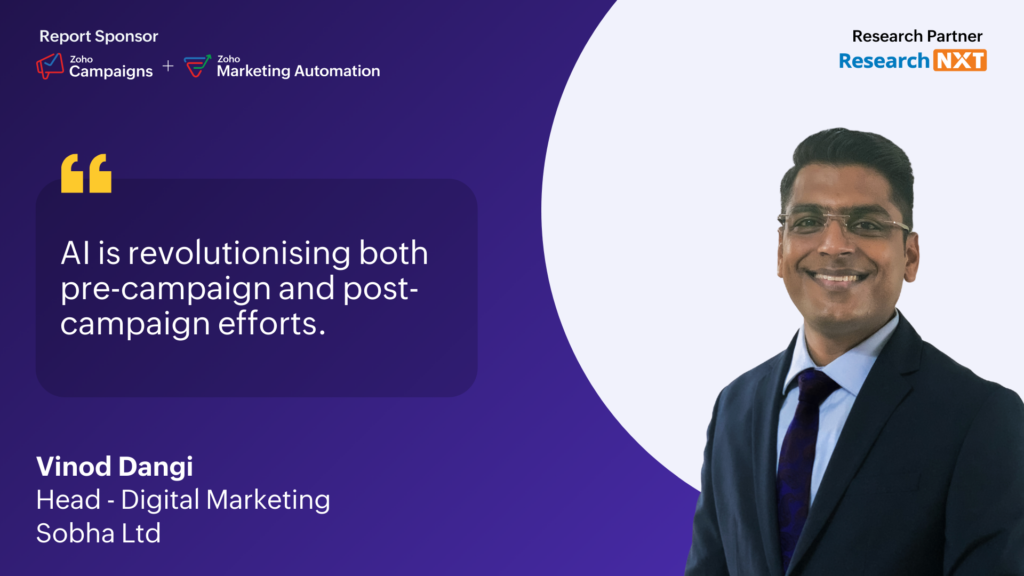
Real Estate Digital Marketing: Balancing Al, Personalization, and Customer Trust
In this interview with Research NXT, Vinod Dangi, Head of Digital Marketing at SOBHA Limited, talks about his professional journey, and discusses campaign management and marketing automation strategies in the real estate industry, with a focus on AI implementation and customer journey optimisation.
Key Takeaways:
- Segmentation and personalisation are crucial for effective real estate marketing, considering factors like buyer type, project specifics, and customer journey stage.
- AI and automation tools should be implemented gradually, with clear objectives and predefined limits to maintain customer trust and brand integrity.
- Proactive planning for potential challenges and having backup strategies are essential when implementing new marketing technologies.
- Content creation and education play a vital role in nurturing leads throughout the lengthy real estate buying process.
"Overall, end-to-end campaign management involves more than running ads across digital platforms. It’s about providing the right content at the right stage, building trust, offering support that aligns with the buyer's journey."
Please share a brief overview of your professional background and journey. We are keen to learn about your experiences and how you have grown to your current role as Head of Digital Marketing at SOBHA Limited.
Vinod: With over 15 years of experience in the real estate industry, I have developed comprehensive expertise in Strategic Marketing, Brand Building, Digital Marketing, Artificial Intelligence, and Business Development. My career began as a Marketing Manager, where I got the opportunity to understand the market, enhanced brand presence and increased sales for real estate projects.
I then progressed to managing large-scale projects, leading marketing campaigns, and performing market analysis, which honed my strategic thinking in urban development. My subsequent roles focused on driving digital transformation and lead generation within the sector.
Currently, as Head of Digital Marketing at SOBHA Limited, I oversee and execute the organisation’s digital strategies that align with business objectives, driving market leadership and expanding digital presence. I am a tech-savvy, dynamic, and passionate professional recognised for implementing innovative technologies and establishing robust sales engines to meet organisational revenue expectations.
How has the digital marketing landscape for real estate evolved over the years? What major shifts have you observed?
Vinod: In the past, a website load time of three seconds was considered acceptable, but now that threshold has been reduced to two seconds. This presents a technical challenge, especially in real estate, where reducing the size of creative assets to improve load speed can compromise visual quality. Maintaining both high-quality visuals and fast load speeds is crucial, as a project’s appeal significantly impacts user interest.
Additionally, there has been a notable shift towards video content across platforms. For instance, LinkedIn has introduced a video section similar to Instagram Reels, Facebook, and YouTube Shorts. This shift emphasises the importance of developing video assets tailored to each platform’s audience. To capture your target audience’s attention, it’s essential to be present on the right platforms at the right time with the appropriate content.
Read More
You have digital channels like LinkedIn for video ads, marketplaces like 99 Acres and Magic Bricks for listing assets, and your own channels like email, SMS, or WhatsApp campaigns. With so many options, creating a multi-channel strategy requires understanding which is most effective. How do you use automation to manage this, and what analytics or reporting do you rely on daily to measure impact and ROI?
Vinod: Regarding channels, a large chunk of the budget is taken by platforms like Google, Meta, LinkedIn, and traditional digital portals such as 99acres and MagicBricks. Success in both automation and campaign management depends on clearly defining the objective from the start. Whether your goal is brand awareness, lead generation, or increasing visibility, a well-defined objective guides the strategy and maximises the efficiency of each channel. Each platform has its own audience and limitations, but aligning your target with its strengths can ensure better results.
For automation, this process is equally important. Begin by determining your goal—whether it’s improving the customer experience, generating new business from existing customers, or increasing engagement through referral or loyalty programs. Once the objective is clear, you can choose the right tools and tailor your messaging to support that goal. If you aim to enhance customer experience, your automation strategy will focus on value-driven communication. If driving referrals is the goal, your messaging will offer incentives or benefits to customers for recommending your brand.
Depending on your objective, different prompts and messages are needed at each stage of the customer journey. Whether you’re aiming to build brand awareness or nurture leads, aligning your strategy, tools, and messaging to your goal ensures that you achieve the desired ROI from every channel or automation tool used.
How do you personalise your digital marketing campaigns to cater to different customer segments, such as first-time homebuyers versus high-end property investors? What tools or strategies do you use to ensure personalised engagement at scale?
Vinod: When people start looking for a home, their journey typically begins 6 to 8 months before making a final decision. From my experience in the real estate industry and discussions with numerous customers, I believe this timeline holds true in many markets. In India, about 99% of buyers purchase a home once in their lifetime, making this a significant and long-term decision.
It’s important to understand the buyer’s stage in the home-buying journey—whether they are 8 months, 6 months, or 1 month away from making a purchase. For buyers early in the process, your role is to be present and provide helpful information without aggressively pushing for immediate sales. Educating buyers is the key, especially first-time homebuyers, who may be unfamiliar with the complexities of the home-buying process, such as securing home loans, stamp duties, taxes and dealing with real estate handover delays.
First-time buyers need content that educates them about these challenges, from the initial search to post-purchase steps like society formation, maintenance, and transferring utilities. On the other hand, second-time homebuyers focus more on quality, such as the construction and amenities, and may also need guidance on selling their existing property as most of them would be upgrading to a bigger home. Their concerns are different, and they require content that helps them navigate upgrading from their current home.
Investors, too, have distinct needs, whether they are first-time or experienced investors. First-time investors may prioritise capital appreciation, while seasoned investors focus on regulatory approvals and long-term viability. Providing educational content specific to each audience helps build trust over time, and your brand becomes a constant presence throughout their 6 to 8-month decision-making process.
Overall, end-to-end campaign management involves more than running ads across digital platforms. It’s about providing the right content at the right stage, building trust, offering support that aligns with the buyer’s journey, and ensuring your brand is at the top of their mind when the time comes to make a decision.
In your experience, how do cultural, demographic, and regional factors impact the design of campaigns?
Vinod: Each real estate project and region behaves differently, and consumer behaviour varies significantly across markets. Even within large metro cities, micro-markets play a significant role, and customer personas can differ dramatically. When segmenting your audience, key factors like product configuration, apartment size, and price are crucial in defining your target audience.
For instance, if a project has a higher ticket size, it’s clear the majority of the target audience isn’t first-time homebuyers but second-time buyers. In this case, the campaign and communication must be tailored accordingly. Age group, income level, and interests are also essential segmentation criteria. For a first-time buyer, you might target younger individuals around 30 years old, whereas for higher-priced properties, the target audience might be 35 years and above.
Once you define your target audience, it’s important to understand where they spend their time online. Different platforms appeal to different segments, so you need to ensure your campaigns appear where your audience is most active. After segmentation, you select the right channels to reach them effectively.
Not everyone looking to buy a home is your target audience. For example, while about five lakh homes were sold in India’s top seven cities last year, roughly 10 to 12 lakh people might have started their home-buying journey during the same period. Your goal is to identify which portion of that audience fits your project, region, and specific offerings. Once the target audience is clearly defined, you can choose the appropriate channels to maintain a strong presence and build brand recall in their minds.
What role does AI play in your digital marketing strategies? Are there any AI-driven tools you’ve found effective for improving lead generation, segmentation, or customer support?
Vinod: There are many aspects to consider when using technology in marketing, particularly with AI-enabled platforms. These platforms, like those used for running ads, now allow you to leverage AI to reach the right audience more effectively. You can feed data points and signals back to these platforms, such as interactions with ads or websites, showing interest and visiting project sites after initial communication. Then, algorithms use these information to identify similar, lookalike audiences. This helps target your ads more precisely, ensuring they reach the right niche rather than a broad audience.
AI also enables more personalised communication. For example, you can segment your audience into different groups, such as luxury brand buyers or first-time homebuyers, and tailor your messaging accordingly. Luxury brand buyers may receive more refined, evolved communication, while first-time buyers get clear and simplified messages. AI allows you to deliver different communications to different audience segments, enhancing the relevance of your campaigns.
Another benefit of AI is lead management. Tools now exist that can predict which leads are most likely to progress through the sales funnel. By identifying high-potential leads, you can assign your best team members to nurture them, ensuring timely and effective follow-up. This segmentation of leads based on their probability of conversion allows for a more efficient allocation of resources, improving the overall customer experience.
AI also plays a crucial role in automating customer interactions. For example, when a customer raises a query, AI can provide an immediate response through channels like WhatsApp, email, or SMS, offering a preliminary solution before an agent follows up. This proactive approach helps address customer needs more quickly and enhances their experience.
In summary, AI is revolutionising both pre-campaign and post-campaign efforts by optimising audience targeting, personalising communication, improving lead management, and automating customer interactions, leading to more effective and efficient campaigns.
What are the potential drawbacks of incorporating AI into campaign management?
Vinod: While AI has the potential to solve many problems and enhance customer experience, there are also challenges when implementing AI and automation tools. Through my experience, I’ve learned that it’s important not to rely on AI for every task, as AI is still evolving. It’s essential to clearly define where AI will be used and where human intervention is needed to maintain trust and ensure the customer experience isn’t compromised, especially while sharing crucial communication, which is dynamic in nature.
AI is still evolving, and many developments are ongoing. At present, AI is largely experimental, and there isn’t a single tool that solves all problems. For instance, you might encounter issues such as sending messages at the wrong time, like a reminder for a site visit being sent after the scheduled time. These challenges are common during implementation, but by setting the right objectives and having a capable team, you can predict and address potential problems.
To mitigate these risks, I would prefer to take a step-by-step approach when implementing AI and automation tools. While some recommend rolling out everything at once for quicker feedback, I prefer a more cautious approach. This allows us to address challenges as they arise without compromising the customer experience or damaging brand trust. Implementing AI in stages can quickly fix issues and ensure a smoother, more reliable process.
What strategies do you implement to deal with challenges associated with automation?
Vinod: When something goes wrong with automation, the first step is to immediately stop the process to prevent further damage. Once the issue is contained, we analyse what went wrong and take corrective actions. For any wrong messaging that has already reached customers, we quickly develop a new, personalised communication to apologise and rectify the situation. The response depends on the severity of the issue. If the damage is significant, we may need to compensate for the inconvenience caused to maintain customer trust in the brand. For minor issues, personalised communication and a sincere apology are often enough.
It’s important to anticipate potential problems when implementing new tools or automation systems. As marketers, we should prepare for common scenarios where things can go wrong and have corrective actions ready. This proactive approach ensures that if an error occurs, we can respond quickly, reach out to affected customers without delay, and address the issue before it escalates and damages the brand and its trust.
Since automation systems rely on data input from multiple sources, errors can happen, whether due to incorrect information or unforeseen events. We can’t predict every possible error, but by preparing for a few likely scenarios, we can minimise the impact and ensure that corrective actions are executed smoothly and promptly to maintain a positive customer experience.
As marketers, it’s essential to ensure that at least two to three team members are fully aware of the end-to-end plan, even if not everyone needs to know all the details. These key individuals should understand what to do if something goes wrong, including how to quickly address and fix issues to prevent further complications.
In my experience, especially in the real estate industry, I’ve observed that people often keep crucial information to themselves, particularly when it comes to implementing new technologies. I strongly advise professionals and leaders to establish a solid backup plan within their teams. Every critical task should be known to multiple team members so that if one person is unavailable, there is always someone ready to step in and ensure the project continues smoothly. A well-prepared Plan B is essential for avoiding disruptions and maintaining efficiency.
Before we conclude this discussion, please let us know your expectations from this report. What do you think would be most valuable for the readers of the report?
Vinod: When implementing new technology, especially something as impactful as AI in campaign management, leaders must be prepared with corrective actions before rolling it out. My expectation is that, before introducing any tool, leaders should have a clear corrective plan in place, including being ready for potential challenges with contingency plans. This preparation allows teams to respond quickly if things go wrong during the implementation process.
It’s also crucial for leaders to understand that not every tool suits every industry or business. While many AI startups aim to sell their tools across all sectors, these tools may not be universally applicable. With their deep industry knowledge, leaders must carefully evaluate whether a tool fits their specific needs.
The decision-making process involves understanding two key categories: first, general tools that are available in the market, and second, industry-specific tools. Within these industry-specific tools, there are also business-specific solutions. For instance, in real estate, there are developers focused on affordable housing, luxury properties, or both. Each segment may require different tools to manage their unique business needs effectively.
By segmenting and understanding which tools best suit their industry and specific business requirements, leaders can make more informed decisions and ensure they choose technology that truly benefits their operations.

